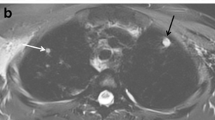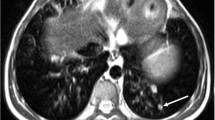Abstract
Objectives
To evaluate the diagnostic performance of five MR sequences to detect pulmonary infectious lesions in patients with invasive fungal infection (IFI), using multidetector computed tomography (MDCT) as the reference standard.
Methods
Thirty-four immunocompromised patients with suspected IFI underwent MDCT and MRI. The MR studies were performed using five pulse sequences at 3.0 T: T2-weighted turbo spin echo (TSE), short-tau inversion recovery (STIR), spectrally selective attenuated inversion recovery (SPAIR), T1-weighted high resolution isotropic volume excitation (e-THRIVE) and T1-weighted fast field echo (T1-FFE). The size, lesion-to-lung contrast ratio and the detectability of pulmonary lesions on MR images were assessed. Image quality and artefacts on different sequences were also rated.
Results
A total of 84 lesions including nodules (n = 44) and consolidation (n = 40) were present in 75 lobes. SPAIR and e-THRIVE images achieved high overall lesion-related sensitivities for the detection of pulmonary abnormalities (90.5 % and 86.9 %, respectively). STIR showed the highest lesion-to-lung contrast ratio for nodules (21.8) and consolidation (17.0), whereas TSE had the fewest physiological artefacts.
Conclusions
MRI at 3.0 T can depict clinically significant pulmonary IFI abnormalities with high accuracy compared to MDCT. SPAIR and e-THRIVE are preferred sequences for the detection of infectious lesions of 5 mm and larger.
Key Points
• A radiation-free radiological method is desirable for assessing pulmonary infectious lesions
• MRI at 3 T can depict lung infiltrates with good concordance to MDCT
• SPAIR and e-THRIVE are favourable sequences for the detection of pulmonary lesions
• The greatest benefit is for the diagnosis of lesions larger than 5 mm



Similar content being viewed by others
Abbreviations
- 2D:
-
Two-dimensional
- 3D:
-
Three-dimensional
- e-THRIVE:
-
T1-weighted high resolution isotropic volume excitation
- HU:
-
Hounsfield unit
- IFI:
-
Invasive fungal infection
- MDCT:
-
Multidetector computed tomography
- RT:
-
Respiratory triggered
- SPAIR:
-
Spectrally selective attenuated inversion recovery
- STIR:
-
Short-tau inversion recovery
- T1-FFE:
-
T1-weighted fast field echo
- TSE:
-
Turbo spin echo
References
Maschmeyer G, Haas A, Cornely OA (2007) Invasive aspergillosis: epidemiology, diagnosis and management in immunocompromised patients. Drugs 67:1567–1601
Li Y, Xu W, Jiang Z et al (2014) Neutropenia and invasive fungal infection in patients with hematological malignancies treated with chemotherapy: a multicenter, prospective, non-interventional study in China. Tumour Biol 35:5869–5876
Karthaus M, Buchheidt D (2013) Invasive aspergillosis: new insights into disease, diagnostic and treatment. Curr Pharm Des 19:3569–3594
Walsh TJ, Anaissie EJ, Denning DW et al (2008) Treatment of aspergillosis: clinical practice guidelines of the Infectious Diseases Society of America. Clin Infect Dis 46:327–360
Kuhlman JE, Fishman EK, Burch PA, Karp JE, Zerhouni EA, Siegelman SS (1987) Invasive pulmonary aspergillosis in acute leukemia. The contribution of CT to early diagnosis and aggressive management. Chest 92:95–99
Puderbach M, Kauczor HU (2008) Can lung MR replace lung CT? Pediatr Radiol 38:S439–S451
Sieren JC, Ohno Y, Koyama H, Sugimura K, McLennan G (2010) Recent technological and application developments in computed tomography and magnetic resonance imaging for improved pulmonary nodule detection and lung cancer staging. J Magn Reson Imaging 32:1353–1369
Koyama H, Ohno Y, Kono A et al (2008) Quantitative and qualitative assessment of non-contrast-enhanced pulmonary MR imaging for management of pulmonary nodules in 161 subjects. Eur Radiol 18:2120–2131
Lutterbey G, Gieseke J, von Falkenhausen M, Morakkabati N, Schild H (2005) Lung MRI at 3.0 T: a comparison of helical CT and high-field MRI in the detection of diffuse lung disease. Eur Radiol 15:324–328
Bruegel M, Gaa J, Woertler K et al (2007) MRI of the lung: value of different turbo spin-echo, single-shot turbo spin-echo, and 3D gradient-echo pulse sequences for the detection of pulmonary metastases. J Magn Reson Imaging 25:73–81
Fink C, Puderbach M, Biederer J et al (2007) Lung MRI at 1.5 and 3 Tesla: observer preference study and lesion contrast using five different pulse sequences. Invest Radiol 42:377–383
Frericks BB, Meyer BC, Martus P, Wendt M, Wolf KJ, Wacker F (2008) MRI of the thorax during whole-body MRI: evaluation of different MR sequences and comparison to thoracic multidetector computed tomography (MDCT). J Magn Reson Imaging 27:538–545
Puderbach M, Hintze C, Ley S, Eichinger M, Kauczor HU, Biederer J (2007) MR imaging of the chest: a practical approach at 1.5 T. Eur J Radiol 64:345–355
Attenberger UI, Morelli JN, Henzler T et al (2013) 3Tesla proton MRI for the diagnosis of pneumonia/lung infiltrates in neutropenic patients with acute myeloid leukemia: initial results in comparison to HRCT. Eur J Radiol 83:e61–e66
De Pauw B, Walsh TJ, Donnelly JP et al (2008) Revised definitions of invasive fungal disease from the European Organization for Research and Treatment of Cancer/Invasive Fungal Infections Cooperative Group and the National Institute of Allergy and Infectious Diseases Mycoses Study Group (EORTC/MSG) Consensus Group. Clin Infect Dis 46:1813–1821
Schroeder T, Ruehm SG, Debatin JF, Ladd ME, Barkhausen J, Goehde SC (2005) Detection of pulmonary nodules using a 2D HASTE MR sequence: comparison with MDCT. AJR Am J Roentgenol 185:979–984
Eibel R, Herzog P, Dietrich O et al (2006) Pulmonary abnormalities in immunocompromised patients: comparative detection with parallel acquisition MR imaging and thin-section helical CT. Radiology 241:880–891
Udayasankar UK, Martin D, Lauenstein T et al (2008) Role of spectral presaturation attenuated inversion-recovery fat-suppressed T2-weighted MR imaging in active inflammatory bowel disease. J Magn Reson Imaging 28:1133–1140
Lauenstein TC, Sharma P, Hughes T, Heberlein K, Tudorascu D, Martin DR (2008) Evaluation of optimized inversion-recovery fat-suppression techniques for T2-weighted abdominal MR imaging. J Magn Reson Imaging 27:1448–1454
Koyama H, Ohno Y, Aoyama N et al (2010) Comparison of STIR turbo SE imaging and diffusion-weighted imaging of the lung: capability for detection and subtype classification of pulmonary adenocarcinomas. Eur Radiol 20:790–800
Yi CA, Jeon TY, Lee KS et al (2007) 3-T MRI: usefulness for evaluating primary lung cancer and small nodules in lobes not containing primary tumors. AJR Am J Roentgenol 189:386–392
Fischbach F, Lohfink K, Gaffke G et al (2013) Magnetic resonance-guided freehand radiofrequency ablation of malignant liver lesions: a new simplified and time-efficient approach using an interactive open magnetic resonance scan platform and hepatocyte-specific contrast agent. Invest Radiol 48:422–428
Acknowledgements
The scientific guarantor of this publication is Prof. Yikai Xu. The authors of this manuscript declare relationships with the following companies: Philips Electronics Ltd. One co-author (Queenie Chan) is an employee of Philips Electronics Hong Kong Ltd. Dr. Chan contributed to designing the study, the establishment of the radiology project, and editing and revising the manuscript. The authors state that this work has not received any funding. Prof. Xuhui Tan kindly provided statistical advice for this manuscript. Institutional review board approval was obtained. Written informed consent was obtained from all subjects (patients) in this study. None of the study subjects or cohorts have been previously reported. Methodology: prospective, diagnostic study, performed at one institution.
Author information
Authors and Affiliations
Corresponding author
Rights and permissions
About this article
Cite this article
Yan, C., Tan, X., Wei, Q. et al. Lung MRI of invasive fungal infection at 3 Tesla: evaluation of five different pulse sequences and comparison with multidetector computed tomography (MDCT). Eur Radiol 25, 550–557 (2015). https://doi.org/10.1007/s00330-014-3432-2
Received:
Revised:
Accepted:
Published:
Issue Date:
DOI: https://doi.org/10.1007/s00330-014-3432-2




